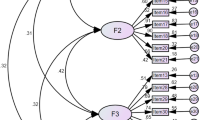Abstract
Our aims were to determine whether a taxonomy of self-management strategies for osteoarthritis could be identified, and whether the resultant dimensions of such a taxonomy demonstrate predictable relationships with health status indices. Participants (n = 117) from community-based self-help groups and a general rheumatology outpatient clinic completed a self-management inventory consisting of 11 items, answered for both the past 7 days and a day on which symptoms were worse than usual. Duration of symptoms, level of pain, perceived functional ability and self-rated health were recorded as indicators of health status. Three essentially identical factors were obtained for both past 7 days and worse day items. Resultant scales were labeled passive, complementary and active, respectively. Correlations with health status measures provided modest evidence for the construct validity of these self-management scales. Compared with a simple aggregate score based on the total number of strategies used, the scales provided a clearer understanding of the relationship between self-management and health. The study provided a useful extension to existing research, addressing a number of shortcomings identified by previous researchers. The identified self-management dimensions offered a greater insight into the self-management choices of patients. Suggestions for further improvements to the measurement of self-management are outlined.
Similar content being viewed by others
Abbreviations
- OA:
-
Osteoarthritis
References
Dekker J, Boot B, van der Woude LHV, Bijlsma JWJ (1992) Pain and disability in osteoarthritis: a review of biobehavioral mechanisms. J Behav Med 15:189–214
Stenmark J (2000) The Arthritis Management Guide. Arthritis Foundation of Australia, Sydney
Arthritis Foundation (2000) Osteoarthritis fact sheet. Arthritis Foundation of SA Inc., Adelaide
Hampson SE, Glasgow RE, Zeiss AM, Birskovich SF, Foster L, Lines A (1993) Self-management of osteoarthritis. Arthritis Care Res 6:17–22
Barlow JH, Williams B, Wright CC (1997) Improving arthritis self-management among older adults: “Just what the doctor didn’t order.” Br J Health Psychol 2:175–186
Barlow JH, Turner AP, Wright CC (2000) A randomized controlled study of the Arthritis Self-Management Programme in the UK. Health Educ Res 15:665–680
Brady TJ, Kruger J, Helmick CG, Callahan LF, Boutaugh ML (2003) Intervention programs for arthritis and other rheumatic diseases. Health Educ Behav 30:44–63
Goeppinger J, Lorig K (1997) Interventions to reduce the impact of chronic disease: community-based arthitis patient education. Annu Rev Nurs Res 15:101–122
Lorig K, Seleznick M, Lubeck D, Ung E, Chastain RL, Holman HR (1989) The beneficial outcomes of the arthitis self-management course are not adequately explained by behavior change. Arthritis Rheum 32:91–95
Zautra AJ, Burleson MH, Blalock SJ et al. (1995) Arthritis and perceptions of quality of life: an examination of positive and negative affect in rheumatoid arthritis patients. Health Psychol 14:399–408
Hampson SE, Glasgow RE, Zeiss AM (1994) Personal models of osteoarthritis and their relation to self-management activities and quality of life. J Behav Med 17:143–158
Idler EL, Benyamini Y (1997) Self-rated health and mortality: a review of twenty-seven community studies. J Health Soc Behav 38:21–37
Wolinsky FD, Tierney WM (1998) Self-rated health and adverse health outcomes: an exploration and refinement of the trajectory hypothesis. J Gerontol Soc Sci 53B:S336–340
Wewers ME, Lowe NK (1990) A critical review of visual analogue scales in the measurement of clinical phenomena. Res Nurs Health 13:227–236
Lautenschlager GJ (1989) A comparison of alternatives to conducting Monte Carlo analyses for determining parallel analysis criteria. Multivar Behav Res 24:365–395
Cronbach LJ (1951) Coefficient alpha and the internal structure of tests. Psychometrika 16:297–334
Rao JK, Mihaliak K, Kroenke K, Bradley J, Tierney WM, Weinberger M (1999) Use of complementary therapies for arthritis among patients of rheumatologists. Ann Intern Med 131:409–416
Ramsey SD, Spencer AC, Topolski TD, Belza B, Patrick DL (2001) Use of alternative therapies by older adults with osteoarthritis. Arthritis Care Res 45:222–227
Holman HR, Lorig KR (1997) Overcoming barriers to successful aging: self-management of osteoarthritis. West J Med 167:265–268
Lorig KR, Holman HR (2003) Self-management education: history, definition, outcomes, and mechanisms. Ann Behav Med 26:1–7
Nunnally JC (1978) Psychometric theory, 2nd edn. McGraw-Hill, New York
Gorsuch RL (1974) Factor analysis. WB Saunders, Philadelphia
Lorig K, Chastain RL, Ung E, Shoor S, Holman HR (1989) Development and evaluation of a scale to measure perceived self-efficacy in people with arthritis. Arthritis Rheum 32:37–44
Acknowledgements
The authors gratefully acknowledge the assistance of Professor Michael Ahern in allowing access to the Rheumatology Clinic at Repatriation General Hospital, and for providing valuable feedback on an earlier draft of this article. Thanks are also due to all those who kindly took part in the study, and to the coordinators of the community groups who allowed the first author to attend their meetings.
Author information
Authors and Affiliations
Corresponding author
Rights and permissions
About this article
Cite this article
Prior, K.N., Bond, M.J. Dimensions of osteoarthritis self-management. Clin Rheumatol 23, 206–213 (2004). https://doi.org/10.1007/s10067-003-0854-7
Received:
Accepted:
Published:
Issue Date:
DOI: https://doi.org/10.1007/s10067-003-0854-7




